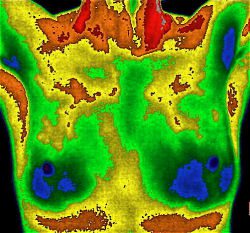
Thermal breast imaging, commonly referred to as breast thermography, is a quick, safe, accurate, non-invasive test that can often detect changes that accompany breast disease earlier than breast self-examination, doctor examination or mammography. The earliest stages of breast cancer are accompanied by changes in blood supply and altered breast temperature. These can often be seen on a thermal image, before a visible tumor develops.
Our thermal imaging system scans the breasts using an extremely sensitive thermal imaging camera that requires no radiation or breast compression. The resulting images are evaluated by experienced technicians using sophisticated technology to determine if the breasts appear to be at risk for disease. You can take control of your health, lower your risk, and regain a sense of ease.
FREQUENTLY ASKED QUESTIONS
Here are some of the most common questions we get asked about Breast Thermography:
What is thermal imaging?
Thermal breast imaging, commonly referred to as breast thermography, is a quick, safe, accurate, non-invasive test that can often detect changes that accompany breast disease earlier than breast self-examination, doctor examination or mammography. The earliest stages of breast cancer are accompanied by changes in blood supply and altered breast temperature. These changes can often be seen on a thermal image, before a visible tumor develops.
Our thermal imaging system scans the breasts using an extremely sensitive thermal imaging camera that requires no radiation or breast compression. The resulting images are evaluated by experienced technicians using sophisticated technology to determine if the breasts appear to be at risk.
What are the doctors looking for in a breast thermography photo?
Breast disease alters the breast temperature and the surrounding blood supply, creating reliable signs that can clearly be seen on a thermal image. Your doctor is looking for the first signs of an existing or potential problem. Early detection allows for early treatment of the problem.
What is the main difference between breast thermography and mammography?
Mammograms use radiation to distinguish dense anatomical structures consistent with tumor growth. Thermograms look at physiological changes that accompany breast disease. Thermograms do not see tumors; they detect vascular activity and temperature.
What is the main difference between breast thermography and mammography?
Early thermal imaging photos establish a baseline from which to monitor breast health. Comparative studies allow for early detection of changes. Thermography is recommended on an annual basis, for women 30 and over, but may be recommended every 3 to 6 months when there are suspicious thermograms or other diagnostic readings; when evaluating the effects of hormone replacement or the efficacy of a treatment; or when there is any other cause for concern.
What does my thermography report tell me?
Your thermography report evaluates your risk for breast cancer. According to level of risk, you may be advised to follow a home program to reduce risk; to consult a specialist for an intensive, personalized risk reduction and prevention program; or to undergo further diagnostics.
What can I learn from thermography?
Thermograms take the temperature of the breasts. Temperature differentials may be normal for you, or may reveal underlying physiologic changes. These changes may reflect infection, inflammation, neurology, hormonal imbalance, or cancer or pre-cancerous conditions. Thermograms can track changes as physiology returns to normal.
Are there any limitations or disadvantages to breast thermography?
Breast thermography does not replace mammography. It may not detect slow growing cancers where vascular levels remain largely unchanged. When breast exams, thermography, and mammography are used as complementary diagnostic techniques, the accuracy rates in detecting breast cancer increase dramatically.
What happens during a breast thermography exam?
The whole exam takes place behind the privacy of a screen. You will not be directly seen nor touched by the clinician. The only discomfort from the exam may be chilliness, as the room has to be kept at a specific, cool temperature for the pictures to be accurate. The clinician will instruct you to disrobe from the waist up. You will be asked to sit or stand with your hands on your hips (hands not touching your breasts) for about 15 minutes, while your upper body cools, enabling the technician to take an accurate thermal picture.
Things to note
Digital infrared thermal imaging has been recognized as a viable diagnostic tool by the FDA, the AMA Council on Scientific Affairs, the ACA Council on Diagnostic Imaging, the Congress of Neurosurgeons and by the American Academy of Physical Medicine and Rehabilitation.
However, it is important to note here that neither mammograms nor breast thermography can diagnose breast cancer. The only diagnostic for breast cancer is breast biopsy.

Ask Dr. Connie
What are the ins and outs of hormonal balance and bio-identical hormones?
Throughout our lives, we are all influenced by the rhythm of hormonal cycles, whether we are male or female. Puberty, menstrual cycles, fertility, infertility, pregnancy, nursing, menopause, and andropause are all regulated by hormones. Hormones send messages throughout our bodies and influence everything from physical well-being to mood. Balancing reproductive hormones and addressing the metabolism of these hormones contributes to the treatment of conditions like endometriosis, uterine fibroids, breast cancer, osteoporosis, and mood disorders.In menopause, there is a delicate hormonal balance between bone, breast, and heart protection, and the alleviation of symptoms such as hot flashes, vaginal dryness, insomnia, and memory issues.
Hormones check and balance each other. Hormonal issues revolve around the complex interrelationship of the hormones produced by the adrenals, thyroid, ovaries, and testes. If your adrenals are weak, you may need to strengthen them to optimize the conversion of thyroid hormone to its active form. Adrenal stress may aggravate menopausal hot flashes, disrupt blood sugar balance, and impair memory. The thyroid gland is directly influenced by estrogen. And so on.
Through blood tests, saliva tests and/or urine tests, we can evaluate the function of the endocrine glands, the levels of hormones and hormonal metabolites, and the effects of hormonal interactions. Other types of testing also contribute. For example, you can see the effect of estrogen on the breast through breast thermography, or on the uterus through ultrasound.
In keeping with naturopathic philosophy, we have many options in treating hormonal imbalance. We may use lifestyle modification, nutritional medicine, herbal medicine, glandular therapies, and/or energy medicines such as homeopathy or flower essences.
When we use hormones, we favor bio-identical hormones. Bio-identical hormones are hormones that are identical to the hormones in your body, whether they be thyroid hormones, sex hormones or adrenal hormones. Bio-identical hormone replacement therapies are unique to your situation, are generally compounded for you by compounding pharmacies, and are often a treatment choice in menopause and andropause.
